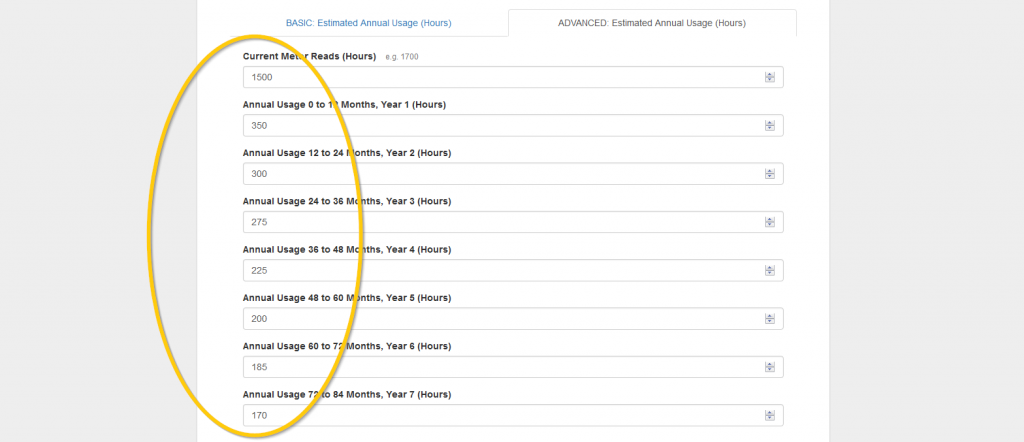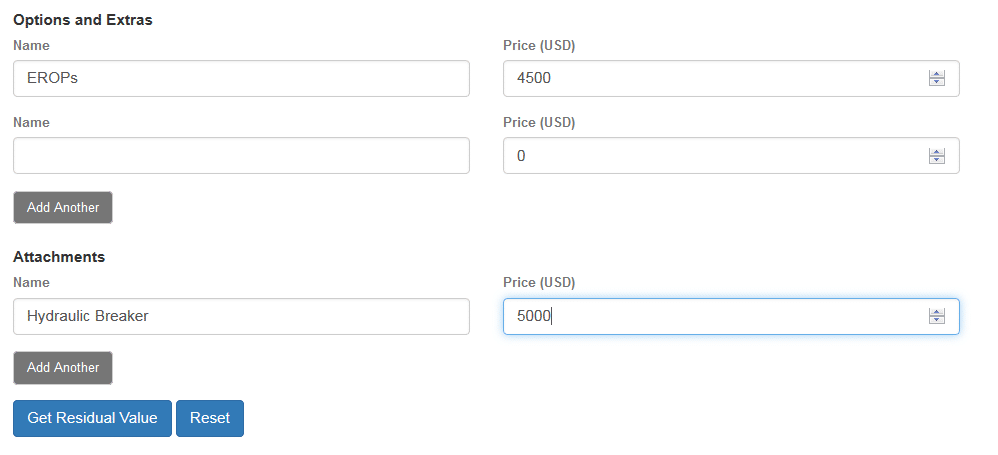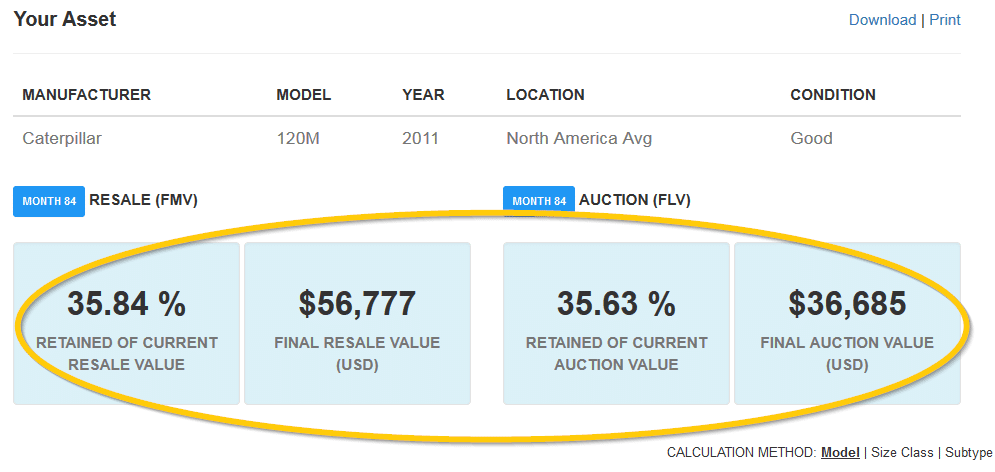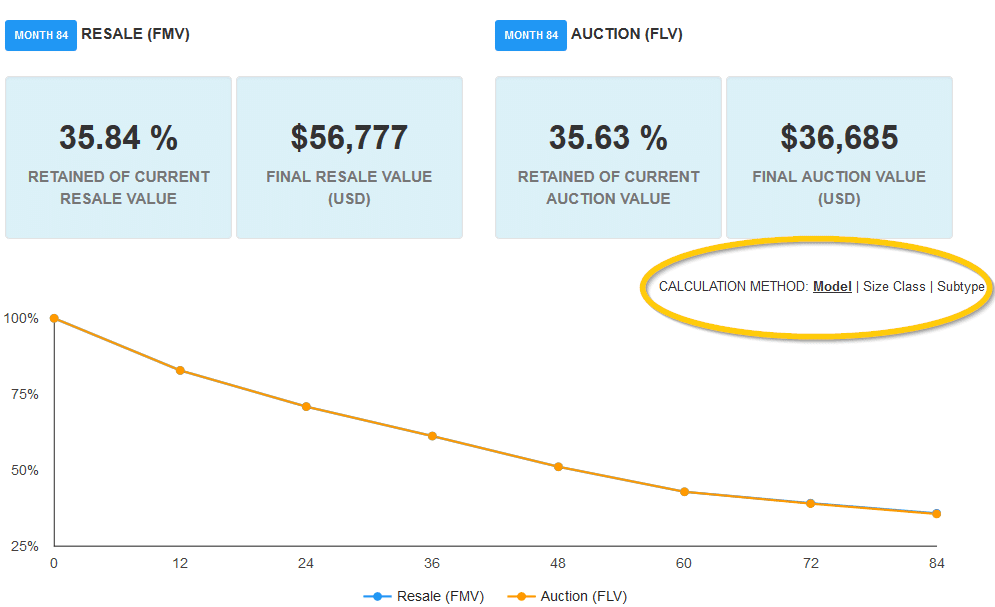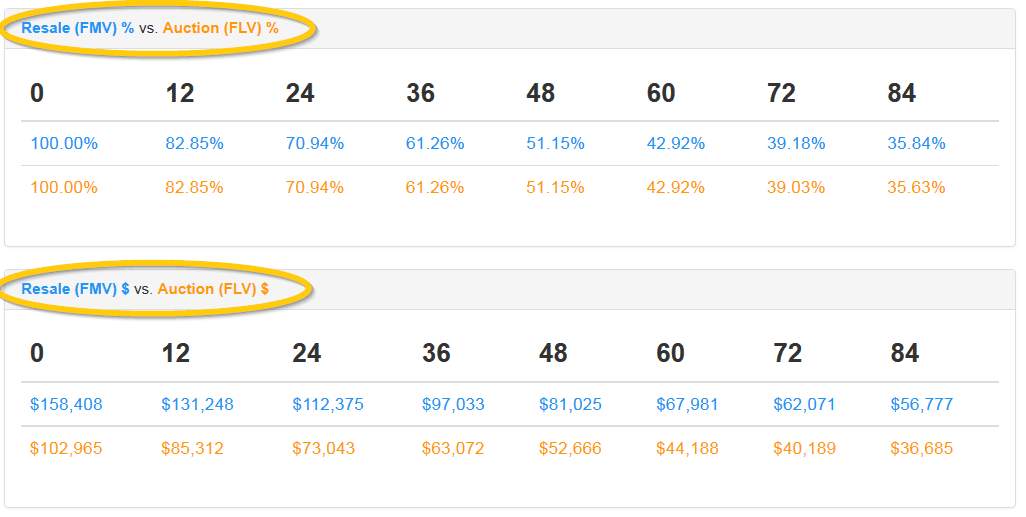Residual Values
Selecting Residual Value Inputs
Inputting Year, Manufacturer and Model
Selecting a Purchase Type
There are two options: New or Used. This represents the condition of the asset in question. Here's what changes based on your selection:
New:
- Usage: for new, the user is asked to provide the estimated annual use hours in the future
- Purchase Price: as this is a new asset, the current market value, usually supplied by MagikMe Equipment, is not applicable, so the user is asked to put in the asset's actual or expected Purchase Price.
Used:
- Usage: for used, the user is asked to provide current meter reads for BASIC Usage (more below). The app then does the math to determine the average hours per year, so far. In the ADVANCED Usage tab, the user has additional controls to adjust expected future usage in future years of operation
- Current Value: here, the default is an MagikMe Equipment provided value, or the user can select to provide their own expected market value
Inputting Estimated Annual Usage, in Hours
There are two options: BASIC and ADVANCED.
BASIC: for New assets, it asks for expected annual usage (in hours) per year. BASIC assumes same utilization per year for the entire length of the residual value window. For Used assets, the current meter reads (in hours) is requested. The app takes in the asset's model year and calculates average hours of usage per year, so far, and carries that number forward for all future years in the calculation.
ADVANCED: the distinction between expected and current between New and Used assets is the same, but ADVANCED controls give control of usage per year for each of the 7 years of the residual value calculation.
Choosing a Location Adjustment
The Location Adjustment adds a layer of precision based on expected location of asset disposition. The options include:
- North American Average (recommended if location of disposition is unknown)
- A specific American state
- A specific Canadian province
Selecting a Condition Adjustment
There are five options for the Condition Adjustment, which represent the expected final condition of asset at the end of the residual value window:
- Poor
- Fair
- Good
- Very Good
- Excellent
As the most subjective of the adjustments, we recommend only varying from "Good", which represents average condition, if there's a strong understanding of the expected final condition of the asset. If, for example, the asset is in a high utilization environment like mining, selection of Poor may be justified.
Identifying Current Value
For New assets, the default is to automatically provide the estimated purchase price for that model year from MagikMe Equipment's database.
Additionally, the User has the ability to use their own purchase price (estimated or actual), by unchecking the box.
For Used assets, the default is to automatically provide the current market value (FMV, FLV), the "MagikMe Equipment computed resale and auction prices".
Additionally, the User has the ability to use their own purchase price (estimated or actual), by unchecking the box.
Options, Extras, and Attachments
Many types of equipment come equipped with non-standard Options and Extras, or with specialized attachments. Other than some rare exceptions, these add-ons to the standard factory model tend to depreciate at the same rate as the equipment on which they are built. To account for the impact of these additions on the estimated value of your equipment, simply type in the name of the item in the Options and Extras field and include the estimated current value of the item. If the item is an Attachment, then enter it into the Attachments field. When you select Get Residual Value at the bottom of the page, these will be accounted for in the estimated residual values.
Understanding the Results
Finding the Estimated Residual Values
Once all inputs are calculated, the results page will populate. At the top, the model search parameters are listed in a table.
Below that are listed the estimated value of the machine after 7 years (84 months). On the left under Resale (FMV) is the estimated percent retained of the current resale value, and on the right is the estimated dollar value of the piece of equipment. These results are repeated immediately to the right for the Auction (FLV) channel.
The percent retained is a ratio of the final estimated dollar value and the Current Value, which may change if the user has input their own Current Value on the first page.
Understanding MagikMe Equipment's Cascading Logic
It sometimes occurs that reliable retained values for 84 months in the future cannot be calculated at the model level. In these circumstances, MagikMe Equipment relies on a cascading logic mechanism to return average residual values within the same size class or equipment subtype. When this logic is applied, the Calculation Method will change to reflect the lowest possible level. A calculation at the model level is generally much more reliable than a calculation at the subtype level, holding all other factors equal.
Reading the Residual Values Graph
The graph shows the estimated percent retained of current value in each projected year. It displays both fair market value and forced liquidation value, although in some circumstances they will be difficult to differentiate. If the user relied on MagikMe Equipment’s computed resale and auction values, both Resale (FMV) and Auction (FLV) line will always start at 100%. However, if the user input a new current value, then each line will start at the ratio of current FMV or FLV values to the user-input current value.
Interpreting the Percent Retained and Value Retained
The tables below the graph break down the estimated residual value in two distinct ways. In the first table, the percent of value retained is shown for each 12 month period from the current month for both the Resale and Auction channels. These numbers are calculated as a percentage of the value of the equipment, based on the inputs provided by the user on the first page.
The second table applies the percentages from the first table to the value of the equipment and provide an estimate of fair market and forced liquidation value over the duration of the 84 month time period. All values are in current US dollars and reflect no adjustments for inflation or other long-term market factors.
Understanding the Impact of Options, Extras, and Attachments
If any Options, Extras, or Attachments were entered on the first page, the impact of these additions will be shown directly below the tables. The percent impact of these options will vary by channel, even though the real dollar value of the additions are identical in the Resale and Auction channel.
Understanding the Impact of Meter Reads
Usage is one of the most important factors in determining an accurate Fair Market and Forced Liquidation value, and as a result is a key part of estimating residual values for any used asset. The degree to which estimated residual values are impacted by meter reads can be observed in the graph at the bottom of the page. The green line represents cumulative hours, and the shape of the curve can vary significantly depending on user input on the first page. The gray columns in the background represent the number of hours accumulated in a given year. Generally speaking, the higher the accumulated hours per year, the steeper the estimated residual value curve will appear.
FAQs
What is the difference between BASIC and ADVANCED Estimated Annual Usage Hours?
Usage is one of the most important factors in estimating the value of any piece of equipment. The impact of additional hours of use can vary greatly by equipment type. The Residual Values application allows for multiple inputs to the usage adjustment.
Users who select the BASIC tab on the left are prompted to input only the Current Meter Reads, in hours. The BASIC calculation assumes that the machine will undergo the same amount of average hours per years, and each future year’s value retained is adjusted for that average amount. Note that this only applies when the User selects a Purchase Type of Used. If Purchase Type is set to New, then the usage field assumes the machine starts with zero hours and each year adds the number listed in that field to the calculation.
However, some users will find that they need greater control over usage per year. For those users, selecting the ADVANCED tab on the right will be more appropriate. It allows the user to input the current meter reads, but then add their own estimates for each additional year.
When should I use "North America Average" as a Location adjustment?
Use the North American Average anytime a piece of equipment may move across state or country lines, or if comparing the estimated residual values of equipment located in different regions.
How do I determine the "Condition" of the asset?
Equipment condition refers to the mechanical state of the machine. MagikMe Equipment Values have five distinct levels for condition, which can be found by visiting our Values Product Guide
How is depreciation calculated for options/extras and attachments?
Generally speaking, options and extras tend to depreciate at the same rate as the machine to which they are connected. An EROPs system, for example, will endure the same amount of weather, work hours, and other depreciating factors as the loader to which it is attached. As such, this application treats options and extras as a one-time addition to the current value of the equipment.
What does FMV and FLV stand for?
FMV = Fair Market Value. Find out more.
FLV = Forced Liquidation Value. Find out more.
When I look up a model, the Auction Residual has no data showing up. Why?
When you encounter a model without an auction channel value, that's due to a lack of observed sales data. This could be due to the model being a rare asset type or an older model. In these situations, we recommend borrowing the percent depreciation from the resale/FMV channel, as the percent depreciation curves are normally very close. If a residual in dollar terms is needed, we recommend reducing the resale/FMV channel valuation by 20-25%, which is the average gap in pricing between the two channels.
Product Roadmap
- Addition of custom options/extras
- Addition of custom attachments
- Integration of Groups feature, to port over saved assets from the primary MagikMe Equipment.com app
- PREMIUM feature, integration of truck values, VIN decoding
- More coming soon!





